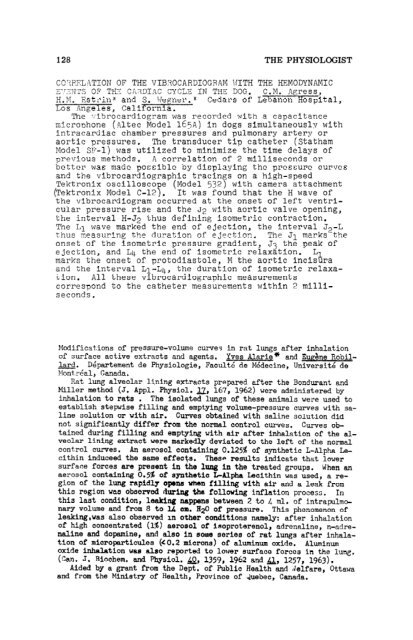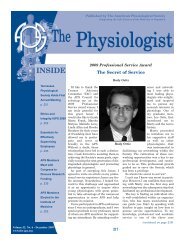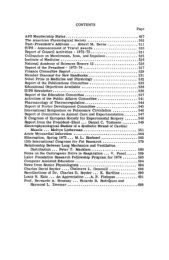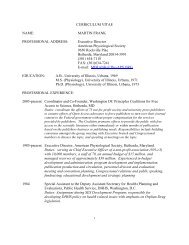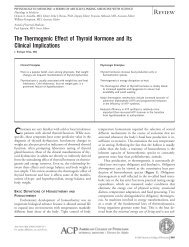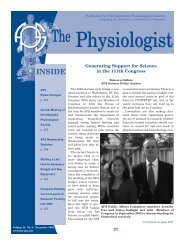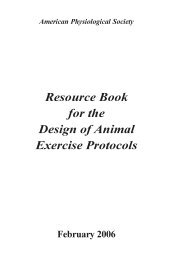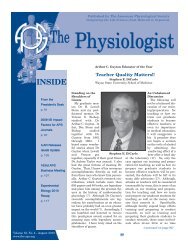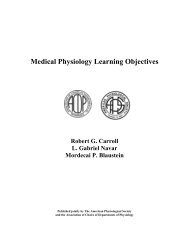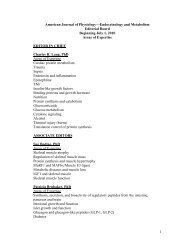Volume 6, Issue 3 - American Physiological Society
Volume 6, Issue 3 - American Physiological Society
Volume 6, Issue 3 - American Physiological Society
Create successful ePaper yourself
Turn your PDF publications into a flip-book with our unique Google optimized e-Paper software.
128 THE PHYSIOLOGISTCCWXLATION OF THE VIB3OCARDIOGRRM IVITH THE HBMODYNAMIC-.A F;: T-?‘N\JTS ? 1 . OF TH";: CARDIAC CYCLE IN THF, DOG. C.M. Rgress,H . M . Kstrin* and S, Wegner.* Cedars of Lebanon Hospital,Los Angeles, California.The vibrocardiogram was recorded with a capacitancemicroohone (Altec Model 165A) in dogs simultaneously withintracardiac chamber pressures and pulmonary artery oraortic pressures. The transducer tip catheter (StathamModel SF-l) was utilized to minimize the time delays ofprevious methods. A correlation of 2 milliseconds orbetter was made possible by displaying the pressure curvesand the vibrocardiographic tracings on a high-speedTektronix oscillosco e (Model 532) with camera attachment(Tektronix Model C-12 P . It was found that the H wave ofthe vibrocardiogram occurred at the onset of left ventricularpressure rise and the J2 with aortic valve opening,the interval H-J2 thus defining isometric contraction.The Ll wave marked the end of ejection, the interval J2-Lthus measuring the duration of ejection. The Jl marks-theonset of the isometric pressure gradient, 53 the peak ofejection, and L4 the end of isometric relaxation. Llmarks the onset of protodiastole, M the aortic incisuraand the interval Ll-Lq, the duration of isometric relaxation.All these vibrocardiographic measurementscorrespond to the catheter measurements within 2 milliseconds,Modifications of pressure-volume curve4 in rat lungs after inhalationof surface active extracts and agents. Yves Alarie* and Euggne FLobillard.DGpartement de Physiologic, l?acult& de MGdecine, Universite deMont&al, Cana.da.Rat lung alveolar lining extracts prepared after the Bondurant andMiller method (J. Appl. Physiol. 1;1, 167, 1962) were administered byinhalation to rats . The isolated lungs of these animals were used toestablish stepwise filling and emptying volume-pressure curves with salinesolution or with air. Curves obtained with saline solution didnot significantly differ from the normal control curves. Curves obtainedduring filling and emptying with air after inhalation of the alveolarlining extract were markedly deviated to the left of the normalcontrol curves. An aerosol containing 0.125% of synthetic L-Alpha Lecithininducesd the same effecfs. These results indicate that lowersurface forces are present in the lung in the treated groups. When anaerosol containing 0.5% of synthetic L-Alpha Lecithin was used, a regionof the lung rapidly opens when filling with air and a leak fromthis region was observed during the following inflation process. Inthis last condition, leaking nappens between 2 to 4 ml. of intrapulmonaryvolume and from 8 to I.4 cm, H20 of pressure. This phenomenon ofleaking,was also observed In other conditions namely: after inhalationof high concentrated (1%) aerosol of isoproterenol, adrenaline, n-adrenalineand dopamine, and also in souw series of rat lungs after inhalationof microparticules (CO.2 microns) of aluminum oxide. Aluminumoxide inhalation was also reported to lower surface forces in the lung.( Can. J. Biochem. and Physiol. 4, 1359# 1962 and &, 1257, 1963).Aided by a grant from the Dept. of Public Health and Welfare, Ottawaand from the Ministry of Health, Province of $uebec, Canada.


